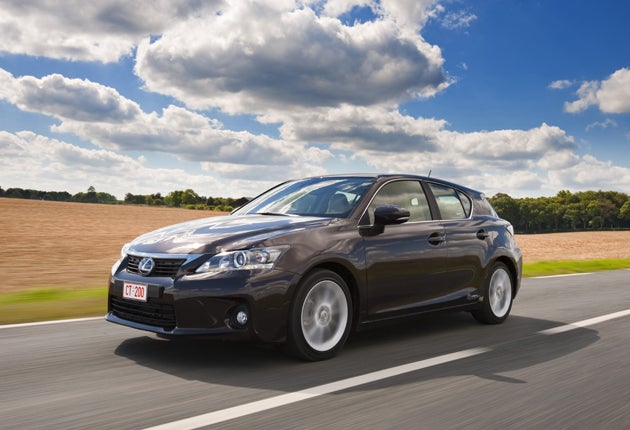Toyota Lexus CT200h
This trailblazing small, executive hybrid should be a winner, but the reality is disappointing.

Your support helps us to tell the story
From reproductive rights to climate change to Big Tech, The Independent is on the ground when the story is developing. Whether it's investigating the financials of Elon Musk's pro-Trump PAC or producing our latest documentary, 'The A Word', which shines a light on the American women fighting for reproductive rights, we know how important it is to parse out the facts from the messaging.
At such a critical moment in US history, we need reporters on the ground. Your donation allows us to keep sending journalists to speak to both sides of the story.
The Independent is trusted by Americans across the entire political spectrum. And unlike many other quality news outlets, we choose not to lock Americans out of our reporting and analysis with paywalls. We believe quality journalism should be available to everyone, paid for by those who can afford it.
Your support makes all the difference.Toyota's upmarket Lexus brand is the Japanese equivalent of BMW or Audi.
Up to now, though, it hasn't had a compact hatchback to compete with a 1 Series or an A3, so the new car you see here is designed to fill that gap. Lexus considers hybrids as a vital part of its brand values. So the new CT200h has a unique selling point.
Its official CO2 figure is just 96g/km which is usefully lower than those of any rivals, all of whose most-economical versions use diesel engines. So the CT200h driver – the initials stand for Compact Tourer – will pay less tax, including no charge for the tax disc, and no London congestion charge. That's a powerful inducement, but only if the rest of the car measures up to the standards of its rivals. And those rivals have just been joined by the Alfa Romeo Giulietta, a car which looks to be the most enticing of them all.
Under the CT200h's skin are the 1.8-litre petrol engine and integrated electric motor of a Toyota Prius or Auris HSD. They produce a maximum of 99bhp and 82bhp respectively, but never at the same time: the maximum combined power of the two units is 136bhp. For the CT, to give it an "authentic Lexus feeling", there's a Sport mode which raises the voltage supplied to the motor from 500 to 650 volts and so adds an extra punch to the acceleration. When this is activated, the left-hand dial transforms itself from a power-consumption/battery-replenishment meter to a rev-counter. The steering becomes heavier, too, and the various traction and stability systems loosen their strictures.
All this is very hi-tech, and the notion of driving fun combined with eco-sensibility is an appealing one. But first you have to like the whole idea of owning the £23,485 Lexus, and first impressions are not encouraging. The styling looks dated, disjointed and heavy-handed, with a clumsy front end and a disturbing disparity of line direction between the rear door and the nearby wraparound rear window.
Things improve inside my top-specification SE-L Premier model, but only slightly. There is a token piece of leather on the instrument cowl and some satin-finish wood above the glovebox, and of course the seats and the door inserts are leather-covered, but otherwise the surfaces and textures are nothing special. However, this top version does have a particularly good stereo system, the purity of its sound apparently helped by the lack of structural vibrations.
That's because the CT200h has a pair of "lateral performance dampers", like normal suspension dampers but filled with gas at very high pressure. One at each end of the car links the tops of the suspension mountings one side to the other. It's a clever system.
This, and a sportingly low driving position, promises a satisfying drive. The flight-deck-like centre console adds to the aura, with clear controls, a neat drive selector and even neater "mouse" for the information screen.
More's the pity, then, that the CT200h is really quite dull to drive. You can enjoy the techno-trick of electric-only running up to 30mph, for a short time and provided acceleration is gentle. Or you can enjoy a keen step-off from standstill, and feed the energy fade as speed rises. At motorway speeds there's precious little overtaking energy left, even in Sport mode. Nor is the engine especially quiet, and firm suspension results in considerable road roar and a fidgety, stiff-legged ride. You soon discover that this is not a car which flows through bends, nor does it interact subtly and satisfyingly with its driver, despite its quick-acting steering. It feels inert, "wooden".
In short, there's nothing special about the CT200h apart from the promise of economical running. What it needs, apart from more enticing looks, is a more interesting engine to set it apart from its hybrid Toyota cousins. As it is, the reality of the CT200h is a long way from the picture its creators like to paint.
Conclusion? Nice idea, poorly executed. Buy a new Giulietta instead.
The Rivals
Alfa Romeo Giulietta 2.0 JTDm: from £21,195, 124g/km CO2
Looks good, nicely made, and fun to drive. Rides well on bumpy roads, diesel engine is very economical given its 170bhp.
Audi A3 Sportback 2.0 TDI 140: from £20,185, 115g/km CO2
Still benchmark for interior quality. Better than Lexus to drive, engine punchy and economical. Has stop-start, like all cars here.
BMW 118d: from £20,485, 119g/km CO2
There's 143bhp on tap and excellent economy. Not beautiful, and rear seat cramped, but delightful to drive and rear-wheel drive is rare in class.
Join our commenting forum
Join thought-provoking conversations, follow other Independent readers and see their replies
Comments